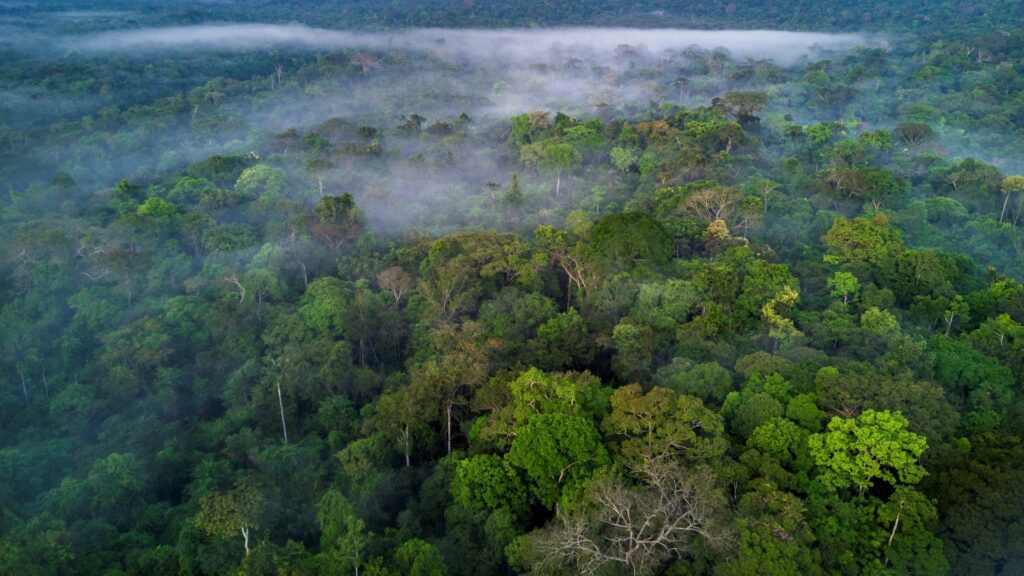
RAINFOREST
The rainforest must be preserved for three important reasons: to prevent climate change, to preserve biodiversity, and to preserve the livelihoods of humans and animals.
WHAT IS A TROPICAL RAINFOREST?
There are several types of rainforest.
Stable temperature: There is never any frost in the rainforest. This means that the trees grow and are green all year round, they do not have to “go to sleep” and fell their leaves to save energy.
Wet: Annual rainfall is more than 1500 mm. The absence of drought contributes to the trees growing and being green all year round.
Dark: Only 2 percent of sunlight reaches the forest floor.
Diverse: At least half of the terrestrial species of living organisms are found here. Wildlife consists of an unknown number of millions of species, from tiny insects to large mammals.
Several layers: The forest is divided into three different levels or floors. The forest floor has an intermediate layer and a crown layer, where the tree crowns form a dense blanket 25-30 meters above the ground.
WHERE IS THE TROPICAL RAINFOREST?
The tropical rainforest grows in a belt on both sides of the equator. The largest rainforests are found in the Amazon in South America, in Central Africa, Indonesia, Malaysia, and on the island of New Guinea in Asia.
HOW MUCH RAINFOREST IS THERE?
Originally, the tropical rainforest covered 9.7 percent of the earth’s land area. Today, we estimate that around 6.5 percent of the earth’s surface is covered by rainforest. Two-thirds of the world’s rainforests have disappeared or been partially destroyed since World War II. Just over a third of the forest is still intact, corresponding to an area as large as half of Europe. Between 2002 and 2019, rainforests corresponding to an area larger than France disappeared.
As many as 73 countries in the world have tropical rainforests. The Amazon forest makes up 56 percent of the world’s rainforests.
Why is it important to protect the rainforest?
If the rainforest disappears, the consequences for life on earth will be severe. The rainforest is really good for:
Climate and weather: The rainforest binds and stores CO2 from the atmosphere that dampens global warming. Rainforest conservation is absolutely necessary if we are to achieve the climate goals in the Paris Agreement. The rainforest also helps to keep the weather in balance, among other things by counteracting hurricanes and floods.
Rain: The rainforest produces rain that spreads over huge areas, far outside the forest. There it contributes to food production and prevents drought.
Biodiversity: Between 50 and 80 percent of all the earth’s animal and plant species live in tropical forests. When the forest disappears, it causes many species to become extinct.
Virus control: Loss of biological diversity leads to diseases spreading more easily. Human impact on the environment has been linked to outbreaks of covid-19, dengue fever, malaria, SARS, Ebola, and other diseases.
People: Many of the poorest people in the world depend on rainforests to survive. The forest provides food, medicine, and fuel.
Food and medicine: A number of important foods come from the rainforest, such as bananas, avocados, sugar cane, chili, papaya, cocoa, etc. Among the enormous amount of animal and plant species found in the rainforest, there are possible solutions to today’s challenges when it comes to health and food production. The rainforest is the world’s largest gene bank. If these species disappear, the opportunity to be able to utilize the characteristics of these species also disappears. 52,000 medicinal plants are already in use worldwide.
Water: The forest improves the quality of drinking water by filtering it. As many as 67 percent of water people can use gutters through wooded catchment areas, according to the United Nations Food and Agriculture Organization (FAO).
CLIMATE AND RAINFOREST
High greenhouse gas emissions lead to climate change. The rise in temperature over the last fifty years has already had serious consequences for humans and nature. More than half of the world’s animal and plant species live in the rainforests, and climate change threatens biodiversity.
BIODIVERSITY AND RAINFOREST
The rainforests contain a greater variety of plants and animals than any other area in the world. Every year, botanists find thousands of new plant species. In the rainforest on the island of Borneo, only 15-35 percent of the species found have been mapped by scientists. Some species live in only one place on the planet. They are called endemic species and live mostly in the rainforest areas of the world.
When the forest is destroyed, the species also disappear. Even small interventions in the forest can have major consequences for biodiversity because the fine-tuned ecosystem becomes unbalanced. A road or a small felling field can prevent an animal species from accessing the place where they lay eggs, or give birth to young. This is how the species dies out. This species can be the food of another species, which thus also has problems surviving. The Rainforest Fund estimates that the species on earth are disappearing up to a thousand times faster due to human impact.
THE PEOPLE IN THE RAINFOREST
Around 260 million people live in the rainforests of the world. The forest people are wholly or partly dependent on the resources in the rainforest, such as water, food, fuel, and medicine. At least 60 million of the people living in the rainforest are indigenous. Indigenous peoples are people who lived in a country before it was colonized or a separate state. They have their own culture that is different from the rest of the population. Many people call indigenous peoples the indigenous people of a country, and they make up only five percent of the world’s population.